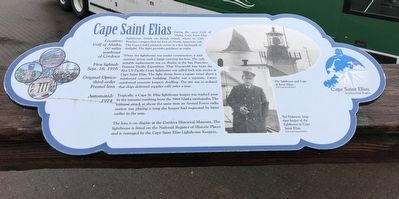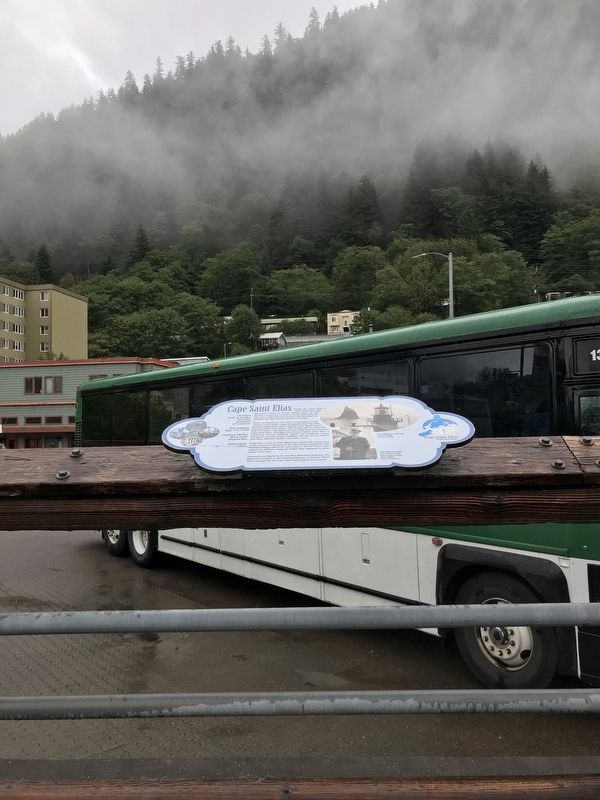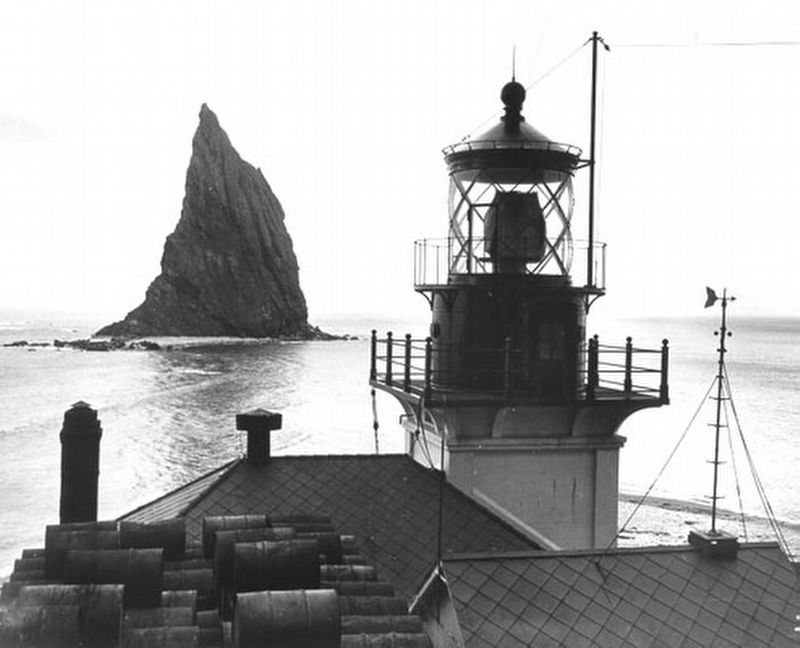Downtown Juneau in Juneau Borough, Alaska — Northwest (North America)
Cape Saint Elias
Facing the open Gulf of Alaska, Cape Saint Elias lighthouse stands on Kayak Island, where in 1741, Russian voyagers first set foot on North American soil. The Cape's bald pinnacle serves as a key landmark in daylight. The light provides guidance at night.
When the lighthouse was under construction, a mid-summer storm sank a barge carrying the lens. The only suitable replacement was on display at the San Francisco Panama Pacific Exposition. That 57-year-old lens from the first US Pacific Coast lighthouse was called back into service at Cape Saint Elias. The light shone from a square tower above a reinforced concrete building. Nearby was a separate, 2-story reinforced concrete keepers dwelling. The site was so isolated that ships delivered supplies only twice a year.
Tragically, a Cape St. Elias lighthouse keeper was washed away by the tsunami resulting from the 1964 Alaska earthquake. The tsunami struck at about the same time an Armed Forces radio station was playing a song the keeper had requested by letter earlier in the year.
The lens is on display at the Cordova Historical Museum. The lighthouse is listed on the National Register of Historic Places and is managed by the Cape Saint Elias Lighthouse Keepers.
At-a-glance box
• Location: 60 miles southeast of Cordova
• First lighted: Sept. 16, 1916
• Original Optics: third-order Fresnel lens
• Automated: 1974
Captions
(Top) The lighthouse and Cape of Saint Elias. (US Coast Guard Photo)
(Bottom) Ted Pederson, long-time keeper of the lighthouse at Cape Saint Elias. (US Coast Guard Photo)
Topics and series. This historical marker is listed in these topic lists: Communications • Disasters • Waterways & Vessels. In addition, it is included in the Lighthouses series list. A significant historical date for this entry is September 16, 1916.
Location. 58° 17.907′ N, 134° 24.316′ W. Marker is in Juneau, Alaska, in Juneau Borough. It is in Downtown Juneau. Marker can be reached from Marine Way. Marker is on the Juneau Harbor boardwalk, south of Marine Park and across from the cruise ship berths. Touch for map. Marker is at or near this postal address: 252 Marine Way, Juneau AK 99801, United States of America. Touch for directions.
Other nearby markers. At least 8 other markers are within walking distance of this marker. Cape Spencer (here, next to this marker); Cape Hinchinbrook (here, next to this marker); Eldred Rock (here, next to this marker); Cape Sarichef & Scotch Cap (here, next to this marker); Lincoln Rock, Fairway Island & Point Sherman (here, next to this marker); Point Retreat (a few steps from this marker); Guard Islands (a few steps from this marker); Tree Point (a few steps from this marker). Touch for a list and map of all markers in Juneau.
Regarding Cape Saint Elias. A Lighthousefriends.com entry on the lighthouse has a different account of the ill-fated keeper swept away by the March 27, 1964 tsunami:
…Frank Reid was photographing the nearby sea lion colony when his leg was broken by a quake-triggered rockfall on Pinnacle Rock. When Reid didn’t return, his three comrades went to search for him. While carrying the injured Reid back to the station, the crew was caught in a tsunami that flooded the gravel bar leading to Pinnacle Rock with chest-deep water. The men survived the first wave, but just seconds later a ten-foot surge swept them all into the sea. Frank Reid drowned, but the other men survived.
Twenty-two-year-old Reid, who was scheduled to be discharged in just a couple of weeks, sent a request to the armed forces radio station in Anchorage just one day before the earthquake, asking that they play “I Want to Go Home – Detroit City.” The radio station finally played Reid’s request on April 9, dedicating it to the three men and two dogs at Cape St. Elias. Sergeant Ervin Elswick, who ran the radio program, told his listeners, “We hope somehow, somewhere, Frank is listening.”
Also see . . . Cape St. Elias Lighthouse. Lighthousefriends.com entry on the structure and its history. (Submitted on September 12, 2021, by Duane and Tracy Marsteller of Murfreesboro, Tennessee.)
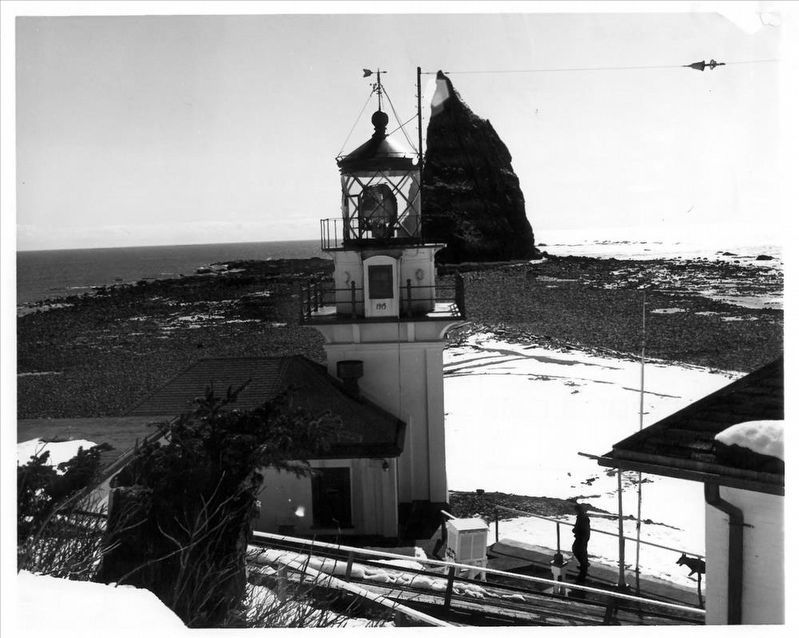
via NPS, unknown
4. Cape Saint Elias Lighthouse
National Register of Historic Places: Digital Archive on NPGallery website entry
Click for more information.
Click for more information.
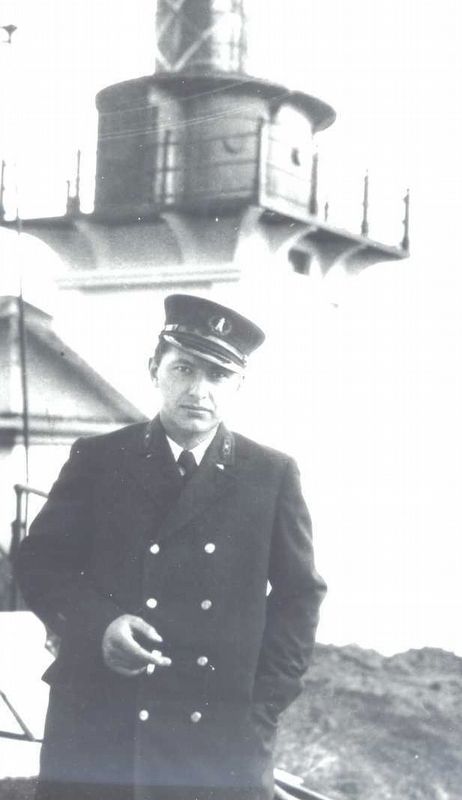
United States Coast Guard, circa 1935
5. Theodore "Ted" Pederson (1905-1990)
He spent more than a decade at Cape St. Elias in the 1920s and 1930s. His extensive photograph and motion picture collection of his Alaska lighthouse career and his home state's marine way of life are housed in the Alaska State Library.
Credits. This page was last revised on September 13, 2021. It was originally submitted on September 12, 2021, by Duane and Tracy Marsteller of Murfreesboro, Tennessee. This page has been viewed 211 times since then and 31 times this year. Photos: 1, 2, 3. submitted on September 12, 2021, by Duane and Tracy Marsteller of Murfreesboro, Tennessee. 4. submitted on September 13, 2021, by Larry Gertner of New York, New York. 5. submitted on September 12, 2021, by Duane and Tracy Marsteller of Murfreesboro, Tennessee.
